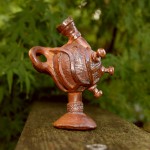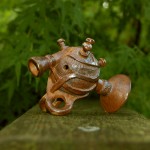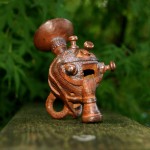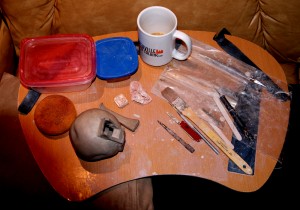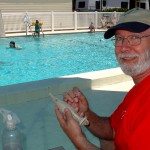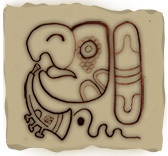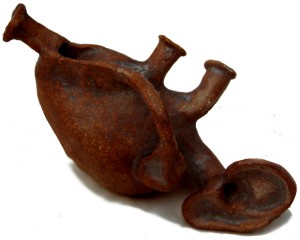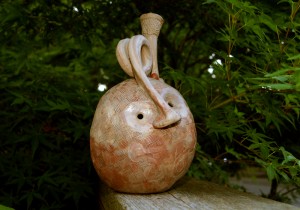I do wish that I had images of the rest of the TrumPhlutes that were part of this series. In the rush to get these from the kiln to a sale, photography became a victim of the crunch. It is a lesson that I learned well and is the reason that I compulsively photograph at various stages of production just so that I do not forget. So what else am I thinking about?…
While forming these strange contraptions, there are a few multi-dimensional thoughts rattling around in my noggin. First of all, it is important that the whistle (or flute) actually play…not always so much that it plays well, but that it simply creates a respectable tone when the player blows air through the airway. I can visualize customers who see these for the first time..and love the change in facial expression when they hear the instrument play for the first time.
Secondly, I believe the form of the piece should allow for whimsical interpretation of some historical reference or context. Often, that interpretation is seeded with a title that provides direction for the fantasy of whimsy. The Emperor’s New Flute (the title of this piece) is a less than subtle reference to a favorite childhood story that carries illusions of royal regalia and fantasy.
And finally, I consider it crucial that a piece should display well. What?, you say??…you are thinking about how someone might display a ceramic musical instrument as you build it? It is like this: if someone pays $40-$50 for something the size of a trinket, they generally don’t take it home or to the office and hide it in a drawer…it will be visible somewhere. So yes, I try to visualize how it might be displayed and attempt to provide clues for several options. For instance, what appears to be ceramic gymnastics in the images on the right are actually different ways that demonstrate intentional efforts to allow for display options. What is not shown is the use of the loop-lugs that would allow for this piece to be suspended or wall hung…or hanging around the emperor’s neck 🙂
It is time to revisit these small instruments. They were a hit at the only sale where I featured them. I can see more of them already, can’t you?
Note: click images for enlarged view
